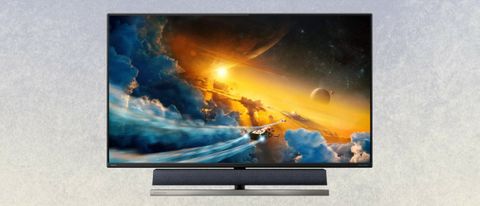Why you can trust Tom's Hardware
To read about our monitor tests in-depth, please check out Display Testing Explained: How We Test PC Monitors. We cover Brightness and Contrast testing covered on page two.
Uncalibrated – Maximum Backlight Level
To compare the Philips Momentum 558M1RY’s performance, we’ve rounded up other large displays from our database.We have the HP Omen X 65 Emperium and Alienware 55-Inch OLED AW5520QF. And in the smaller 43-inch size are the Asus ROG Swift PG43UQ and Acer Predator CG437K. Rounding out the group is a 49-inch mega-wide, the Viotek SUW49DA. All are VA panels, except the Alienware’s OLED screen.



OLED isn’t known for high brightness, and at max brightness settings Alienware’s offering is barely brighter than the 558M1RY’s minimum brightness level of 105 nits. Great for a sunlit room, the 558M1RY can go up to almost 750 nits brightness. The Asus and Acer panels are even brighter, though it’s hard to imagine playing games at such high outputs. Fatigue would set in quickly.
The Alienware’s black level is too low to measure, so the monitor, theoretically, has infinite contrast. The VA panels’ contrast levels are quite low as well, though their bright backlights help raise the contrast. The final contrast values (third chart above) are what differentiate the monitors. The 558M1RY is just behind the best VA screen from Acer at 4,713.3:1. That is an impressive number that beats every desktop-sized monitor we’ve tested.
After Calibration to 200 nits



After calibrating the 558M1RY to 200 nits brightness (see our recommended settings on Page 1), static contrast ratio increased slightly to 4,808.6:1. It now tops the Acer by about 5% -- a small, but visible, amount. The Philips’ SDR image is stunning both in depth and sharpness with deep and true blacks rich with shadow detail.
A few slight hotspots spoiled the Philips’ ANSI test result. 3212.3:1 is still an excellent figure that is well ahead of any desktop-sized screen. At the same time, the AW5520QF OLED is still showing us unmeasurable black levels, so its ANSI contrast is also theoretically infinite.
Current page: Brightness & Contrast
Prev Page Features and Specifications Next Page Grayscale, Gamma & Color
Christian Eberle is a Contributing Editor for Tom's Hardware US. He's a veteran reviewer of A/V equipment, specializing in monitors. Christian began his obsession with tech when he built his first PC in 1991, a 286 running DOS 3.0 at a blazing 12MHz. In 2006, he undertook training from the Imaging Science Foundation in video calibration and testing and thus started a passion for precise imaging that persists to this day. He is also a professional musician with a degree from the New England Conservatory as a classical bassoonist which he used to good effect as a performer with the West Point Army Band from 1987 to 2013. He enjoys watching movies and listening to high-end audio in his custom-built home theater and can be seen riding trails near his home on a race-ready ICE VTX recumbent trike. Christian enjoys the endless summer in Florida where he lives with his wife and Chihuahua and plays with orchestras around the state.
-
waltc3 Nice review...looks nice! Too expensive, imo.Reply
However, it is definitely not a "desktop monitor" since 6' + away is not "desktop", unless your desk is 8-10 feet deep (which most aren't)...;)
This next link is a desktop monitor, definitely, for less than 1/3 the cost: $449.
https://www.benq.com/en-us/monitor/entertainment/ew3270u.html
It's available now from Amazon. The monitor will do 4k, HDR and Freesync 1, as well. I own it and really like it--best monitor I've ever owned, by far. Works great with a display port 1.4 GPU like my 5700XT--important, however, do not go cheap on your DP 1.4 cable! Get a VESA-certified 8K cable like this one (3 meters):
https://www.amazon.com/Infinnet-DisplayPort-Cable-Certified-Meters/dp/B07JJXM4FR/ref=sr_1_4?crid=3269IBD0U4VKE&dchild=1&keywords=infinnet+displayport+1.4&qid=1613939084&s=electronics&sprefix=Infinnet%2Celectronics%2C141&sr=1-4
Highly recommended!
Games like BG3 and No Man's Sky (latest versions) look fantastic in HDR with (or without Freesync--it's your choice). Some other games have poorly coded HDR versions and do not look as good on any GPU/HDR monitor/HDR TV combination, I've discovered. Game devs are definitely making slow but sure progress with their HDR coding.
One of my favorite characteristics of the BenQ is the dot pitch, or the pixel pitch, as it is sometimes called. It's .18, which means you can sit at your desk with this monitor 18" away from your eyes and it will occupy ~80% of your visual field, and you cannot detect individual pixels. From an inch away, if you can focus, you cannot see individual pixels.
Talking about the Soundbar. Let's just say that for less than the $1500 this reviewed monitor costs, you can buy the BenQ & a very nice set of 2.1 speakers (or 5.1, or 7.1 if you want) plus a nice receiver/amplifier to power them, and be way ahead in the sound category. Soundbars are not impressive, imo--better than typical TV speakers, but that's not saying very much...;)
Almost forgot to mention that I run my games @ 60Hz with vsync off and sometimes get far in excess of 120 fps, depending on the game. At lower resolutions I can get literally hundreds of frames per second, and page-tearing is so rare with this monitor that my default game and desktop driver setting is vsync off. -
AnimeMania I am intrigued by the soundbar.Reply
Does the soundbar only function when the monitor is on or does it have it's own power source.
Is there any way for other devices to have access to the soundbar through ports or Bluetooth?
